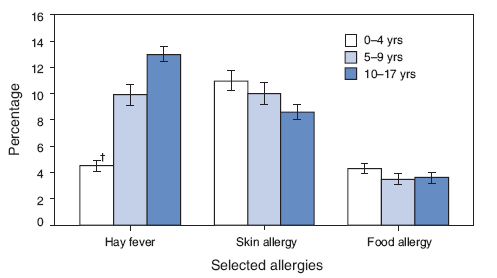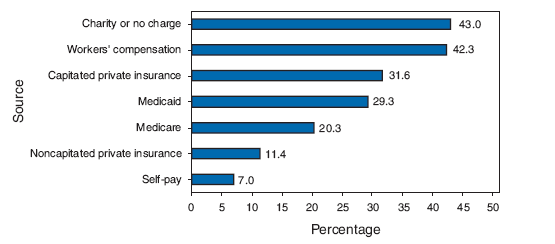Wednesday, April 18, 2007
PA Ranks Second in Total Dollars Paid in Malpractice Claims
-
Printer Friendly|#| Trackback
At the same website mentioned in the preceding post one can find information on total dollars paid in malpractice cases in 2006. Pennsylvania ranked second with $308,781,000 paid (second only to New York). See for yourself.
Vermont looks pretty good to me right now...
PA Ranks Third in Paid Malpractice Claims
-
Printer Friendly|#| Trackback
The Kaiser Family Foundation maintains StateHealthFacts.org, a site "designed to provide free, up-to-date, and easy-to-use health data on all 50 states". The site just published Number of Paid Medical Malpractice Claims, 2006. Pennsylvania ranks third among all states in number of malpractice claims paid per thousand physicians. See for yourself.
Thursday, March 29, 2007
Resolved: C. diff enterocolitis should be a reportable disease
-
Printer Friendly|#| Trackback
The CDC just published their Summary of Notifiable Diseases --- United States, 2005
I wonder why C. diff enterocolitis isn't on the list? I've seen this illness cause more morbidity and mortality in the United States than the big long list they do track...
MMWR: Percentage of Children with Selected Allergies
-
Printer Friendly|#| Trackback

"During 2003--2005, the percentage of children with hay fever increased with age; children aged 10--17 years were nearly three times as likely to have hay fever than children aged 0--4 years. In contrast, the percentage of children with skin allergies decreased with age, and the percentage of children with food allergies did not vary with age."
Tuesday, March 27, 2007
New Study on Malpractice Costs
-
Printer Friendly|#| Trackback
Pacific Research Institute:
JACKPOT JUSTICE: The True Cost of America's Tort System
Processing....
Thursday, March 15, 2007
CDC: Insurance Affects New Patient Acceptance
-
Printer Friendly|#| Trackback
Percentage of Office-Based Primary-Care Physicians Who Did Not Accept New Patients, by Expected Payment Source --- National Ambulatory Medical Care Survey, United States, 2003--2004

"Although 94.2% of primary-care physicians reported in 2003--2004 that they were accepting new patients, acceptance varied by the patient's expected payment source. Among the physicians, 43.0% did not accept new charity cases, 29.3% did not accept new Medicaid patients, and 20.3% did not accept new Medicare patients. Only 7.0% did not accept new patients who self-paid."
Wednesday, February 21, 2007
JAMA: Off-Pump vs On-Pump CABG and Cognitive Decline
-
Printer Friendly|#| Trackback
Five years after surgery, there is no difference in cognitive decline between on-pump and off-pump CABG.
Cognitive and Cardiac Outcomes 5 Years After Off-Pump vs On-Pump Coronary Artery Bypass Graft Surgery
"Results After 5 years, 130 patients were alive in each group. Cognitive outcomes could be determined in 123 and 117 patients in the off-pump and on-pump groups, respectively. When using a standard definition of cognitive decline (20% decline in performance in 20% of the neuropsychological test variables), 62 (50.4%) of 123 in the off-pump group and 59 (50.4%) of 117 in the on-pump group had cognitive decline (absolute difference, 0%; 95% confidence interval [CI], –12.7% to 12.6%; P>.99). When a more conservative definition of cognitive decline was used, 41 (33.3%) in the off-pump group and 41 (35.0%) in the on-pump group had cognitive decline (absolute difference, –1.7%; 95% CI, –13.7% to 10.3%; P = .79). Thirty off-pump patients (21.1%) and 25 on-pump patients (18.0%) experienced a cardiovascular event (absolute difference, 3.1%; 95% CI, –6.1% to 12.4%; P = .55). No differences were observed in anginal status or quality of life.
Conclusion In low-risk patients undergoing CABG surgery, avoiding the use of cardiopulmonary bypass had no effect on 5-year cognitive or cardiac outcomes."
[free full text]
Sunday, July 30, 2006
Risks of Epidural Analgesia for Labor
-
Printer Friendly|#| Trackback
Anesthesiology has a nice article which attempt to quantify some of the less common risks of having an epidural during labor: epidural hematoma, infection, and neurologic injury.
| Epidural hematoma |
1 in 168,000 |
6 per million |
| Deep epidural infection |
1 in 145,000 |
7 per million |
| Persistent neurologic injury |
1 in 240,000 |
4 per million |
Transient neurologic injury
[< 1 year] |
1 in 6,700 |
180 per million |
It contains an interesting tidbit others might find interesting, too. There are 4 million births in the United States each year and 2.4 million involve epidural analgesia. Wow. That's three fifth of all live birth get an epidural! (And some call nights, it seems every single one does...)
Sunday, July 23, 2006
Pennsylvania Showing Net Loss of Physicians Over Time
-
Printer Friendly|#| Trackback
The number of physicians in Pennsylvania has declined by approximately ten percent between 1999 and 2005. On its own that number may not sound like such a huge drop. Compare that number to the other 20 most populous states and it becomes obvious that the difference is very significant.
Almost all of have seen net increases of between 7% and 35% over the same period. I would find it very interesting to know how long the wait is for a new patient appointment in an internal medicine practice in Pennsylvania vs. these states that have seen an increase. A knee replacement? First visit to a Neurologist. Follow up visits? You get my drift. Pennsylvania has a population that is among the most aged. Medicare just announced plans for more cuts. New physicians are choosing not to practice in Pennsylvania and we've seen a net loss of 10% in our physicians with unique provider numbers over the last six years. Get the picture, Governor Rendel?
Data from State of Medicine in Pennsylvania--2005
Thursday, May 25, 2006
Top 10 Causes of Death Worldwide
-
Printer Friendly|#| Trackback
Top 10 Causes of Death Worldwide:
"[F]or high-income countries:
1. Heart disease
2. Stroke
3. Lung cancer
4. Lower respiratory infections
5. Chronic obstructive pulmonary disease (COPD)
6. Colon and rectum cancers
7. Alzheimer's disease and other dementias
8. Type 2 diabetes
9. Breast cancer
10. Stomach cancer
Here is the list for low- and middle-income countries:
1. Heart disease
2. Stroke
3. Lower respiratory infections
4. HIV/AIDS
5. Fetus/newborn (perinatal) conditions
6. Chronic obstructive pulmonary disease (COPD)
7. Diarrhea
8. Tuberculosis
9. Malaria
10. Road traffic accidents "
[Via WebMD Health Headlines]
Wednesday, January 4, 2006
Antibiotic Resistance In Terms I Can Understand
-
Printer Friendly|#| Trackback
Penicillin and Amoxicillin's days are numbered
"Researchers from the University of Rochester started with the analysis of data from 11,426 children who has suffered a common throat infection.
They found that 25 per cent of children given penicillin, along with 18 per cent given amoxicillin treatment needed further treatment within weeks.
The data, taken from 47 studies from the past 35 years looked at the effectiveness of various drugs on treating strep throat in children.
Additional results revealed that of those given older-generation cephalosporin antibiotics, 14 per cent had to return for more treatment, while just 7 per cent prescribed newer versions like cefpodoxime and cefdinir, given for just four or five days, had to go back to the doctor. "
Sunday, January 1, 2006
Prilosec and C.Diff?
-
Printer Friendly|#| Trackback
Reading a blog far afield of medicine, then to the Washington Post, I cam across an interesting nugget on C. Diff. The JAMA published an article on December 21, 2005 titled Use of Gastric AcidâSuppressive Agents and the Risk of Community-Acquired Clostridium difficileâAssociated Disease [abstract]. In two population-based case-control studies:
" The incidence of C difficile in patients diagnosed by their general practitioners in the General Practice Research Database increased from less than 1 case per 100 000 in 1994 to 22 per 100 000 in 2004. The adjusted rate ratio of C difficileâassociated disease with current use of proton pump inhibitors was 2.9 (95% confidence interval [CI], 2.4-3.4) and with H2-receptor antagonists the rate ratio was 2.0 (95% CI, 1.6-2.7). An elevated rate was also found with the use of nonsteroidal anti-inflammatory drugs (rate ratio, 1.3; 95% CI, 1.2-1.5). "
A teleconference is planned for January 18th to discuss these results as part of the new Author-in-the-room series.
| 1 |
2 |
3 |
4 |
5 |
6 |
7 |
| 8 |
9 |
10 |
11 |
12 |
13 |
14 |
| 15 |
16 |
17 |
18 |
19 |
20 |
21 |
| 22 |
23 |
24 |
25 |
26 |
27 |
28 |
| 29 |
30 |
|
|
Mar Jul
|

